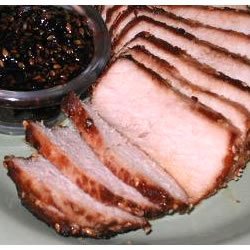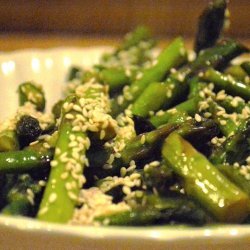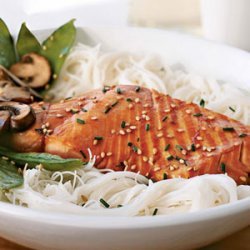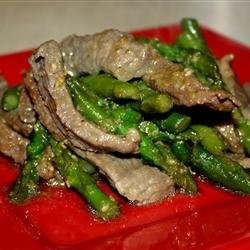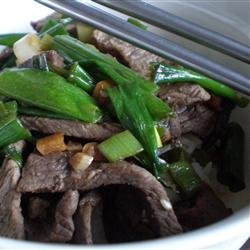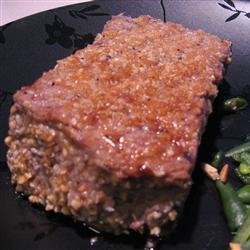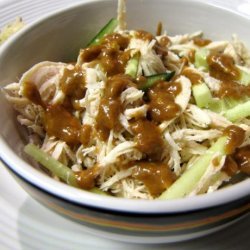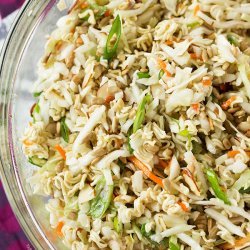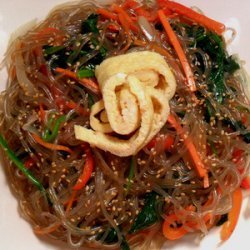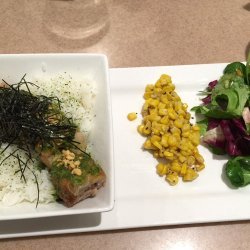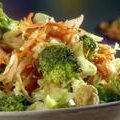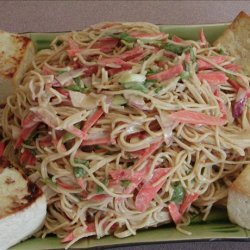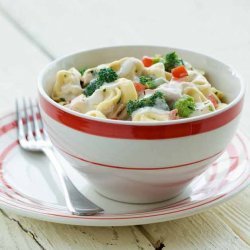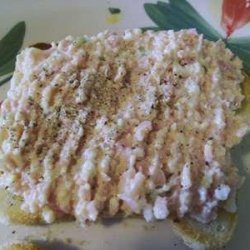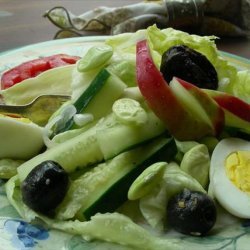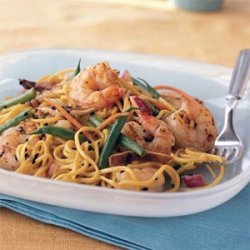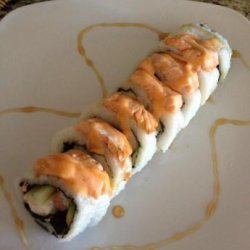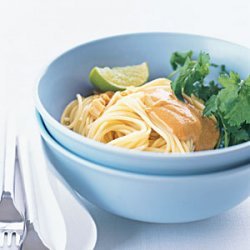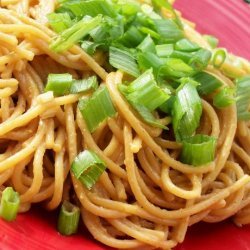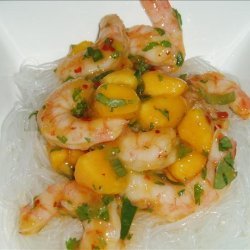Ingredients:
- 3/4 cup sanuki sea stock
- 1 recipe fresh udon noodles or 8 to 10 oz dried or semidried udon noodles , cooked and chilled
Directions:
- Make the ponzu sauce: Place the stock, soy sauce, and sugar in a small saucepan and heat slowly until small bubbles appear around the rim. Stir to dissolve the sugar. Remove the saucepan from the heat and add the bonito flakes. Wait 2 minutes, then add the lemon and/or lime juice. Strain the mixture through a fine-woven muslin cloth- or coffee filter-lined colander. Chill the sauce for at least 20 minutes, or refrigerate up to several days.
- Assemble the salad: If the cooked noodles seem sticky or pasty, quickly rinse in cold water and drain well. Divide them among 4 shallow serving bowls. Garnish the noodles with sesame seeds and chives or scallions. Serve the chilled ponzu sauce on the side to drizzle on and toss in just before eating.
- Elizabeth Andoh shares her tips with Epicurious: ·For this recipe, it's important to make the stock from scratch. Avoid the powdered and liquid instant stock products and noodle dipping sauces found in Asian grocery stores. They are typically filled with chemical additives that are of questionable health and nutritional value, and they taste dreadful. Homemade dashi takes little time and effort, and you will be well rewarded in flavor. · Shoyu (soy sauce) is used in two varieties in the Japanese kitchen: koikuchi, the all-purpose dark variety (sold as regular soy sauce in the U.S.); and usukuchi, a saltier, lighter-colored but full-strength version (sold as light soy sauce in the U.S.). For this recipe, I recommend the deeper, burnished color of the regular type. For the best flavor, avoid using soy sauce labeled lite or low-sodium. · Dried fish flakes (katsuobushi) are generally a combination of tunalike bonito (katsuo) and other less expensive fish such as sardines and mackerel. Bonito yields a mild but smoky flavor; sardine and mackerel lend a more assertive flavor. In this recipe, the decision on how much katsuobushi to add depends on your preference for smokiness; the more flakes you use, the smokier the dish will be. Once opened, the flakes go rancid rather quickly, so if you will be using them only occasionally, look for a fresh pack (several small, sealed packets, each containing 3 or 5 grams) rather than a single larger bag (usually 100 grams). ·There are two varieties of sesame seeds regularly used in Japanese cooking: white (shiro goma) and black (kuro goma). Both are harvested from sesame plants a single plant will produce either white or black seeds. Toasting sesame seeds brings out their wonderful, nutty flavor and aroma. However, in so doing, the seeds' oils are brought to the surface, where they can oxidize, and go stale. I recommend that you buy un-toasted arai goma (literally washed sesame) and toast the seeds yourself, just before using them. If already-toasted seeds (iri goma) are all you can find, use them within a few weeks of opening the package. ·To toast the seeds, warm a small heavy skillet over medium-high heat. Add seeds and toast, stirring occasionally with a wooden spatula or gently rotating skillet in a circular motion to keep seeds moving. In about a minute, seeds will begin to color and a few may pop. Continue to stir for another 20 to 30 seconds, then remove skillet from stove. Seeds will continue to toast in the very hot skillet, deepening in color and becoming quite aromatic even after being taken away from the source of heat. If seeds look in danger of scorching, transfer them to a dish to cool before using. For a variation on this salad, heap a mound of spicy-sharp freshly grated daikon radish on top of each portion of noodles before drizzling on the sauce. ·For a variation on this salad, heap a mound of spicy-sharp freshly grated daikon radish on top of each portion of noodles before drizzling on the sauce. ·Yet another version of this dish transforms cold udon noodles into something resembling a chef's salad. Top the noodles with finely julienned strips of cucumber, briefly blanched and shelled shrimp or boiled crabmeat (cartilage removed), and trimmed radish sprouts.
Nutrition Facts
| Amount Per 1 Serving | |||
| Calories | 163 Kcal (682 kJ) | ||
| Calories from fat | 38.35 Kcal | ||
| % Daily Value* | |||
| Total Fat | 4.26g | 7% | |
|---|---|---|---|
| Cholesterol | 0.83mg | 0% | |
| Sodium | 903.72mg | 38% | |
| Potassium | 72.96mg | 2% | |
| Total Carbs | 26.59g | 9% | |
| Sugars | 2.43g | 10% | |
| Dietary Fiber | 2.79g | 11% | |
| Protein | 7.19g | 14% | |
| Vitamin C | 3.5mg | 6% | |
| Iron | 1.4mg | 8% | |
| Calcium | 84.7mg | 8% | |
| Amount Per 100 g | |||
| Calories | 160.35 Kcal (671 kJ) | ||
| Calories from fat | 37.72 Kcal | ||
| % Daily Value* | |||
| Total Fat | 4.19g | 7% | |
|---|---|---|---|
| Cholesterol | 0.82mg | 0% | |
| Sodium | 889.01mg | 38% | |
| Potassium | 71.77mg | 2% | |
| Total Carbs | 26.16g | 9% | |
| Sugars | 2.39g | 10% | |
| Dietary Fiber | 2.74g | 11% | |
| Protein | 7.07g | 14% | |
| Vitamin C | 3.5mg | 6% | |
| Iron | 1.4mg | 8% | |
| Calcium | 83.3mg | 8% | |
* Percent Daily Values are based on a 2000 calorie diet. Your daily values may be higher or lower depending on your calorie needs.
Find out how many calories should you eat.
Get Your Recipe of Health!
Follow RecipeOfHealth on Facebook!


